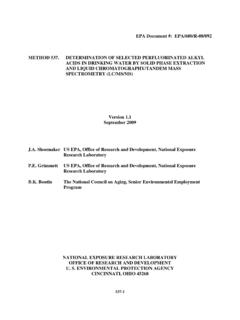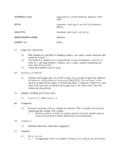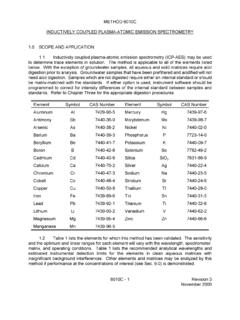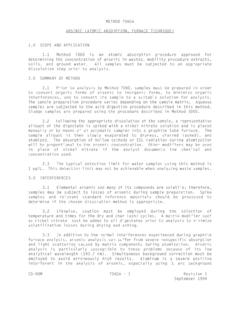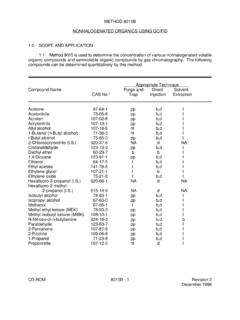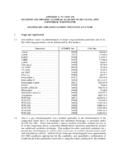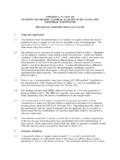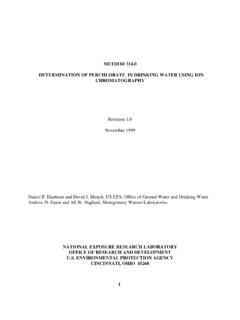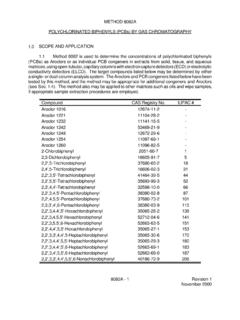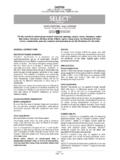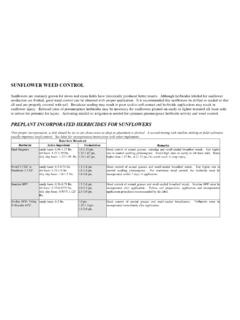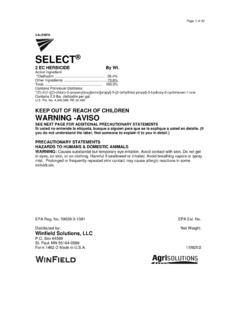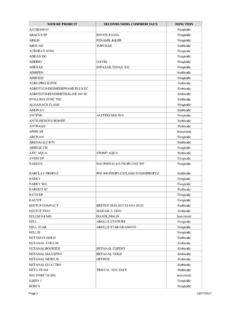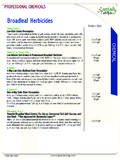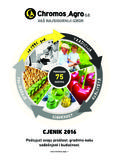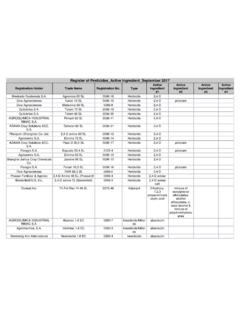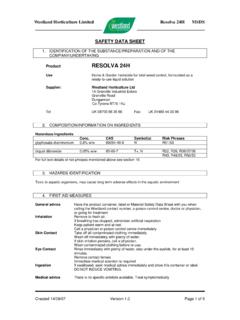Transcription of METHOD 8081A ORGANOCHLORINE PESTICIDES …
1 CD-ROM8081A - 1 Revision 1 December 1996 METHOD 8081 AORGANOCHLORINE PESTICIDES BY GAS AND 8081 is used to determine the concentrations of various organochlorinepesticides in extracts from solid and liquid matrices, using fused-silica, open-tubular, capillarycolumns with electron capture detectors (ECD). When compared to the packed columns, thesecolumns offer improved resolution, better selectivity, increased sensitivity, and faster analysis. Thecompounds listed below may be determined by either a single- or dual-column analysis system.
2 CompoundCAS Registry "-BHC319-84-6$-BHC319-85-7(-BHC (Lindane)58-89-9*-BHC319-86-8 Chlorobenzilate510-15-6"-Chlordane5103-7 1-9(-Chlordane5103-74-2 Chlordane - not otherwise specified57-74-9 DBCP96-12-84,4'-DDD72-54-84,4'-DDE72-55- 94,4'-DDT50-29-3 Diallate2303-16-4 Dieldrin60-57-1 Endosulfan I959-98-8 Endosulfan II33213-65-9 Endosulfan sulfate1031-07-8 Endrin72-20-8 Endrin aldehyde7421-93-4 Endrin ketone53494-70-5 Heptachlor76-44-8 Heptachlor revision of METHOD 8081 no longer includes the PCBs as Aroclors in the list of targetanalytes.))
3 The analysis of PCBs should be undertaken using METHOD 8082, which includes specificcleanup and quantitation procedures designed for PCB analysis. This change was made to obtainPCB data of better quality and to eliminate the complications inherent in a combined organochlorinepesticide and PCB METHOD . Therefore, if the presence of PCBs is expected, use METHOD 8082 forCD-ROM8081A - 2 Revision 1 December 1996 PCB analyses, and this METHOD (8081) for the ORGANOCHLORINE PESTICIDES . If there is no informationof the likely presence of PCBs, either employ a PCB-specific screening procedure such as animmunoassay ( , METHOD 4020), or split the sample extract prior to any cleanup steps, andprocess part of the extract for ORGANOCHLORINE pesticide analysis and the other portion for PCBanalysis using METHOD 8082.
4 Analyst must select columns, detectors and calibration procedures most appropriatefor the specific analytes of interest in a study. Matrix-specific performance data must be establishedand the stability of the analytical system and instrument calibration must be established for eachanalytical matrix ( , hexane solutions from sample extractions, diluted oil samples, etc.). performance data are presented for many of the target analytes, it is unlikelythat all of them could be determined in a single analysis.
5 The chemical and chromatographicbehaviors of many of these chemicals can result in co-elution of some target analytes. Severalcleanup/fractionation schemes are provided in this METHOD and in METHOD 3600. multi-component mixtures ( , Chlordane and Toxaphene) are listed as targetanalytes. When samples contain more than one multi-component analyte, a higher level of analystexpertise is required to attain acceptable levels of qualitative and quantitative analysis. The sameis true of multi-component analytes that have been subjected to environmental degradation ordegradation by treatment technologies.
6 These result in "weathered" multi-component mixtures thatmay have significant differences in peak patterns than those of standards. identification based on single-column analysis should be confirmed on asecond column, or should be supported by at least one other qualitative technique. This methoddescribes analytical conditions for a second gas chromatographic column that can be used toconfirm the measurements made with the primary column. GC/MS METHOD 8270 is alsorecommended as a confirmation technique, if sensitivity permits (Sec.)
7 METHOD includes a dual-column option. The option allows a hardware configurationof two analytical columns joined to a single injection port. The option allows one injection to be usedfor dual-column analysis. Analysts are cautioned that the dual-column option may not be appropriatewhen the instrument is subject to mechanical stress, many samples are to be run in a short period,or when contaminated samples are METHOD is restricted to use by, or under the supervision of, analysts experienced inthe use of gas chromatographs (GC) and skilled in the interpretation of gas chromatograms.
8 Eachanalyst must demonstrate the ability to generate acceptable results with this suitable for analysis by this METHOD may also be analyzed for organophosphoruspesticides ( METHOD 8141). Some extracts may also be suitable for triazine herbicide analysis, if lowrecoveries (normally samples taken for triazine analysis must be preserved) are not a following compounds may also be determined using this METHOD :CompoundCAS Registry - 3 Revision 1 December 1996 CompoundCAS Registry extracted from samples or standards exposed to water or methanol may producepeaks with broad tails that elute later than the standard by up to 1 minute.
9 This shift is presumablythe result of the formation of a hemi-acetal from the ketone functionality. As a result, METHOD 8081is not recommended for determining Kepone. METHOD 8270 may be more appropriate for theanalysis of OF measured volume or weight of sample (approximately 1 L for liquids, 2 g to 30 g forsolids) is extracted using the appropriate matrix-specific sample extraction technique. samples are extracted at neutral pH with methylene chloride using either Method3510 (separatory funnel), METHOD 3520 (continuous liquid-liquid extractor), or other samples are extracted with hexane-acetone (1:1) or methylene chloride-acetone(1.)
10 1) using METHOD 3540 (Soxhlet), METHOD 3541 (automated Soxhlet), METHOD 3545 (pressurizedfluid extraction), METHOD 3550 (ultrasonic extraction), or other appropriate variety of cleanup steps may be applied to the extract, depending on the nature of thematrix interferences and the target analytes. Suggested cleanups include alumina ( METHOD 3610),Florisil ( METHOD 3620), silica gel ( METHOD 3630), gel permeation chromatography ( METHOD 3640), andsulfur ( METHOD 3660).CD-ROM8081A - 4 Revision 1 December cleanup, the extract is analyzed by injecting a 1- L sample into a gaschromatograph with a narrow- or wide-bore fused silica capillary column and electron capturedetector (GC/ECD) or an electrolytic conductivity detector (GC/ELCD).
